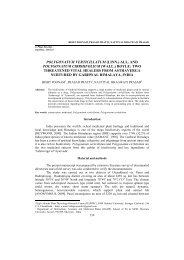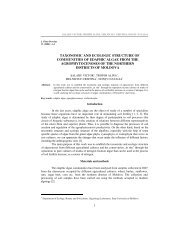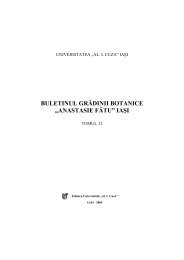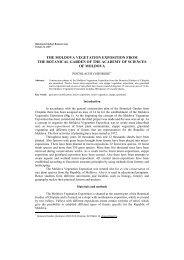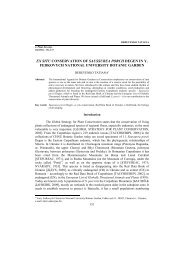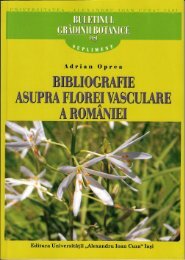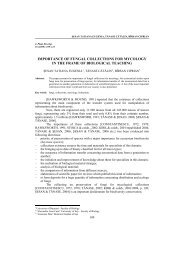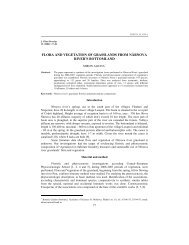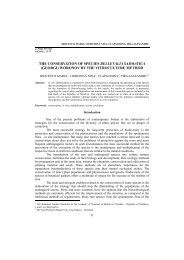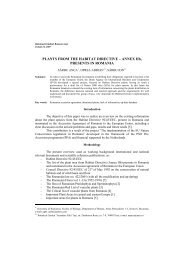contributions to the vegetation study from the vaslui river basin
contributions to the vegetation study from the vaslui river basin
contributions to the vegetation study from the vaslui river basin
You also want an ePaper? Increase the reach of your titles
YUMPU automatically turns print PDFs into web optimized ePapers that Google loves.
CONTRIBUTIONS TO THE VEGETATION STUDY FROM THE VASLUI RIVER BASIN (I)<br />
Results and discutions<br />
Ass. Pruno spinosae – Crataegetum Hueck 1931<br />
(Syn.: Pruno spinosae – Crataegetum Soó 1931)<br />
Chorology: Chirceti (Mititelu D., 1975), Emil Racovi, Dneti, Poieni, Pripoare<br />
hill, Dobrov<br />
Ecology: The Prunus spinosa and Crataegus monogyna bushes are encountered at<br />
<strong>the</strong> edge of woods and glades, on cleared sites or sunny coasts.<br />
The phy<strong>to</strong>coenological characterisation: Besides <strong>the</strong>se two edifying species we<br />
also encounter: Rosa canina, Rubus caesius, but also a large number of herbaceous species<br />
in <strong>the</strong> classes Festuco-Brometea conferring <strong>the</strong> association a xerophile character,<br />
alternating with <strong>the</strong> mesophile character, Molinio-Arrhena<strong>the</strong>retea. The species<br />
characteristic <strong>to</strong> <strong>the</strong> classes Artemisietea vulgaris and Stellarietea mediae show <strong>the</strong> effect of<br />
<strong>the</strong> anthropozoogenous actions (Tab. 1).<br />
After <strong>the</strong> analysis of <strong>the</strong> surveys we noticed <strong>the</strong> following: <strong>the</strong> bioforms spectrum<br />
shows us <strong>the</strong> dominance of hemicryp<strong>to</strong>phytes (73.22%), followed by terophytes (7.14%)<br />
and hemiterophytes (10.71%) which underlines <strong>the</strong> presence of <strong>the</strong> anthropic fac<strong>to</strong>r in <strong>the</strong><br />
area. The presence of <strong>the</strong> phanerophytes amounts <strong>to</strong> a percentage of 8.93%. The<br />
phy<strong>to</strong>geographical spectrum indicates <strong>the</strong> dominance of <strong>the</strong> Eurasian elements (64.27%),<br />
followed by European (19.64%) and Pontic (8.94%), reflecting thus <strong>the</strong> temperate character<br />
of <strong>the</strong> area and also <strong>the</strong> presence of <strong>the</strong> species <strong>from</strong> <strong>the</strong> Sou<strong>the</strong>rn area. Besides<br />
circumpolar elements (3.57%), cosmopolite (1.79%) and adventive (1.79%) participate.<br />
The spectrum of ecological indices indicate <strong>the</strong> presence of heliophilous species (45.65%),<br />
amphi<strong>to</strong>lerant <strong>to</strong> temperature (39.14%) with spreading area in Central Europe (39.13%)<br />
which develop on dry up <strong>to</strong> moderate-humid soils (39.13%), amphi<strong>to</strong>lerant with regard <strong>to</strong><br />
soil reaction (50%) and <strong>the</strong> amount of mineral nitrogen in <strong>the</strong> soil (19.56%).<br />
Observations: The association has been recorded in this area within a <strong>study</strong>, but<br />
without presenting a table of floristic surveys.<br />
Table 1. Ass. Pruno spinosae – Crataegetum Hueck 1931<br />
Number of survey 1 2 3 4 5 6<br />
Altitude (m.s.m.) 320 328 245 310 245 270<br />
Exposition - NV - E - S<br />
Slope (º) - 2 - 8-9 - 20<br />
Coverage of <strong>the</strong> shrub layer (%) 90 70 65 50 85 60<br />
Coverage of <strong>the</strong> herbaceous layer (%) 20 6 5 10 15 5<br />
Surface of survey (m²) 50 25 25 25 50 50<br />
Number of species 30 14 13 14 24 38 K<br />
Association’s characteristics<br />
Prunus spinosa + 4 3 1 4 2 V<br />
Prunion spinosae et Prunetalia<br />
Crataegus monogyna 5 1 2 3 2 3 V<br />
Rubus caesius - + - - - - I<br />
Origanum vulgare - - - - + - I<br />
Rhamno-Prunetea<br />
Evonymus europaeus + - + + - + IV<br />
100



